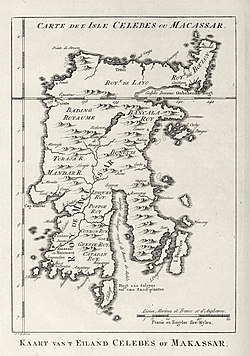| No | Monarch | Gender | Reign |
|---|
| 1 | Manurung ri Matajang (Mata Silompoé) | Male | 1350 – 1366 |
|---|
| 2 | La Ummasa To'Mulaiyé Panra | Male | 1366 – 1398 |
|---|
| 3 | La Saliwu (Kerampelua) | Male | 1398 – 1470 |
|---|
| 4 | Wé Benrigau' Daéng Marawa, Mallajang' ri Cina | Female | 1470 – 1490 |
|---|
| 5 | Tenrisukki, Mappajungngé | Male | 1490 – 1517 |
|---|
| 6 | La Uliyo Botoé, Matinroé ri Itterung | Male | 1517 – 1542 |
|---|
| 7 | La Tenrirawe Bongkange, Matinroe ri Guccina | Male | 1542 – 1584 |
|---|
| 8 | La Ica, Matinroé ri Adénenna | Male | 1584 – 1595 |
|---|
| 9 | La Patawe, Matinroé ri Bettung | Male | 1595 – 1602 |
|---|
| 10 | I Dangka Wé Tenrituppu, Matinroé ri Sidénréng | Female | 1602 – 1611 |
|---|
| 11 | La Tenriruwa Arung Palakka (Sultan Adam Matinroé ri Bantaéng | Male | 3 months in 1611 |
|---|
| 12 | Tenripallé To'Akkeppeyang Arung Timurung, Paduka Sri Sultan 'Alauddin Matinroé ri Talloq | Male | 1611 – 1626 |
|---|
| 13 | La Maqdaremmeng, Paduka Sultan Muhammad Saleh Matinroé ri Bukaka | Male | 1626 – 1643 |
|---|
| 14 | La Tenriaji To'Senrima, Arung Awamponé Pawélaié ri Siang | Male | 1643 – 1645 |
|---|
| 13 | La Maqdaremmeng, Paduka Sultan Muhammad Saleh Matinroé ri Bukaka (restored) | Male | 1667 – 1672 [9] |
|---|
| 15 | La Tenritatta To'Unru Malampéq-é Gemineqna Daéng Serang Arung Palakka, Paduka Sri Sultan Sa'aduddin Matinroé ri Bontoalaq | Male | 1672 – 1696 |
|---|
| 16 | La Patau Matanna Tikka Arung Palakka, Paduka Sri Sultan Idris Azimuddin Matinroé ri Nagauleng | Male | 1696 – 1714 |
|---|
| 17 | Batari Toja Daéng Talaga Arung Timurung, Datu Chitta Sultanah Zainab Zulkiyahtuddin Matinroé ri Tippulué | Female | 1714 – 1715 |
|---|
| 18 | La Paddasajati To'Appawareq Arung Palakka, Paduka Sri Sultan Sulaiman Matinroé ri Béula | Male | 1715 – 1718 |
|---|
| 19 | La Pareppa To'Soppéwali, Paduka Sri Sultan Shahabuddin Ismail Matinroé ri Somba Opu | Male | 1718 – 1721 |
|---|
| 20 | La Panaongi To'Pawawoi Arung Mampu Karaéng Bisei, Paduka Sri Sultan Abdullah Mansor Matinroé ri Bisei | Male | 1721 – 1724 |
|---|
| 21 | Batari Toja Daéng Talaga Arung Timurung, Datu Chitta Sultanah Zainab Zulkiyahtuddin Matinroé ri Tippulué (restored, 2nd reign) | Female | 1724 – 1738 |
|---|
| 21 | Batari Toja Daéng Talaga Arung Timurung, Datu Chitta Sultanah Zainab Zulkiyahtuddin Matinroé ri Tippulué (3rd reign) | Female | 1741 – 1749 |
|---|
| 22 | La Temmassongeq, Paduka Sri Sultan Abdul Razak Jalaluddin Matinroé ri Mallimongeng | Male | 1749 – 5 June 1775 |
|---|
| 23 | La Tenritappu, Paduka Sri Sultan Ahmad as-Saleh Syamsuddin Matinroé ri Rompegading | Male | 5 June 1775 – 1812 |
|---|
| 24 | La Mappatunruq, Paduka Sri Sultan Ismail Mokhtajuddin Matinroé ri Lalebbata | Male | 1812 – 1823 |
|---|
| 25 | I Maniratu Arung Data, Paduka Sri Sultanah Salehah Mahdi Rajiatuddin Matinroé ri Kessi | Female | 1823 – 1835 (12 years) |
|---|
| 26 | La Mappaseling Arung Panynyiliq, Sultan Adam Najamuddin Matinroé ri Salassana | Male | 1835 – 1845 |
|---|
| 27 | La Parénrengi Arung Punyi, Paduka Sri Sultan Ahmad Salleh Muhiyuddin Matinroé ri Adiyang Bénténg | Male | 1845 – 1857 |
|---|
| 28 | Pancaitana Bessé Kajuara Tenriawaru Matinroé ri Majennang | Female | 1857 – 1860 |
|---|
| 29 | Singkerru Rukka, Paduka Sri Sultan Ahmad Idris Matinroé ri To'Paccing | Male | 1860 – 1871 (11 years) |
|---|
| 30 | I Banrigau' Arung Timurung and Datu Chitta Paduka Sri Sultanah Fatimah Matinroé ri Bolampare'na | Female | 1871 – 1895 |
|---|
| 31 | La Pawawoi Arung Sijelling, Karaéng Sigeri Matinroé ri Bandung | Male | 1895 – 1905 |
|---|
| 32 | Andi La Mappanyukki Karaéng Selayar, Paduka Sri Sultan Ibrahim Matinroé ri Gowa | Male | 1931 – 1946 |
|---|
| 33 | Andi La Paqbénteng Daéng Palawa Arung Pitu and Arung Macégé Matinroé ri Matuju | Male | 1946 – 1950 |
|---|




